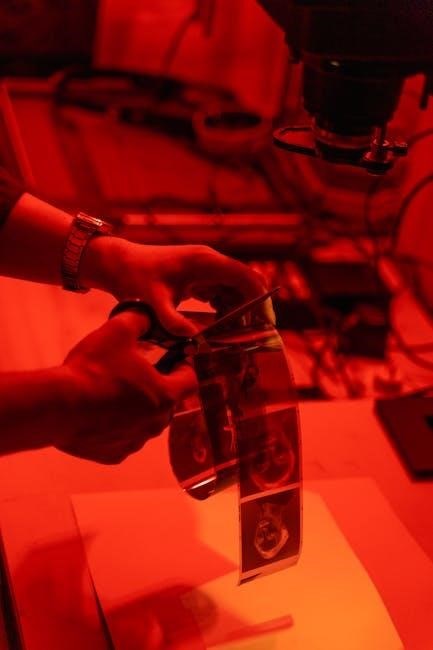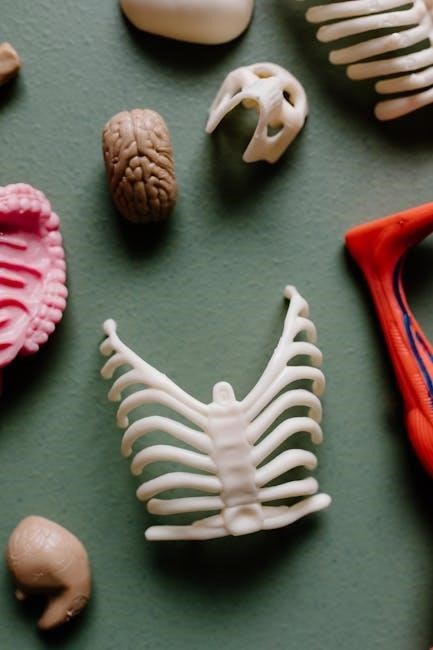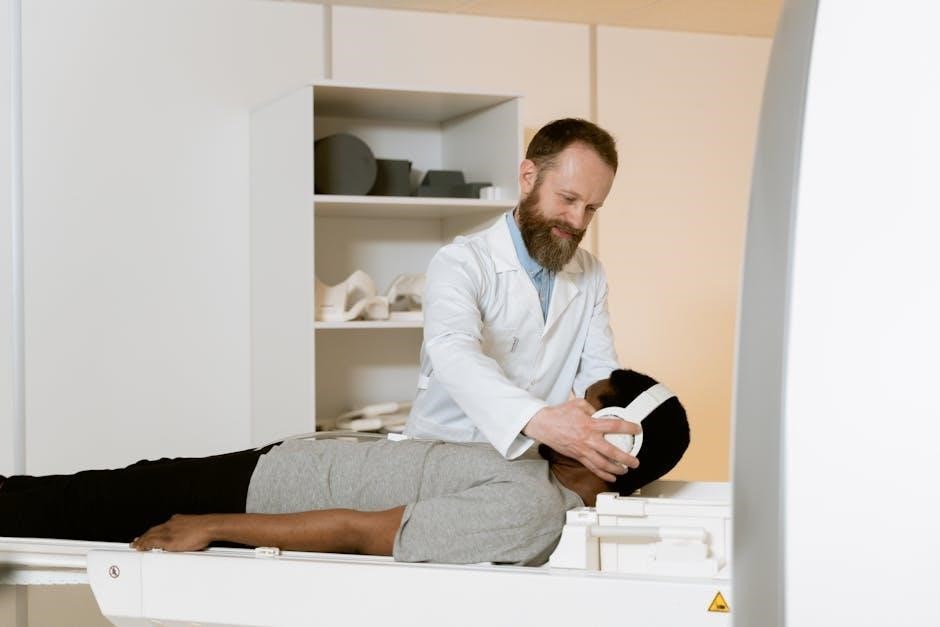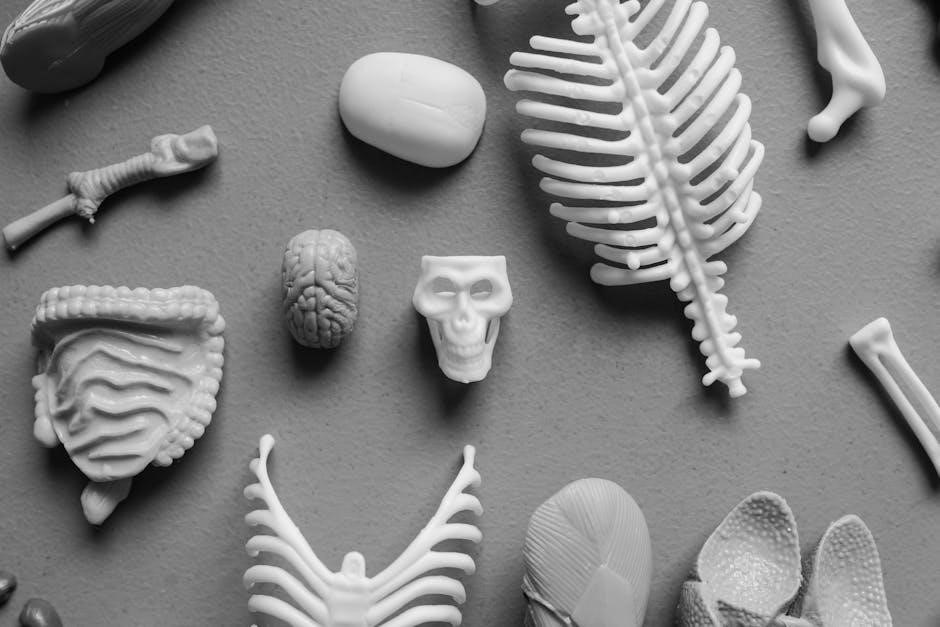The human anatomy laboratory manual with cat dissections provides students with a comprehensive guide to understanding human anatomy through cat dissections, using full-color illustrations and photographs for clarity always online․
Overview of the Laboratory Manual
The human anatomy laboratory manual with cat dissections is a comprehensive resource for students, providing a clear and engaging writing style, with 30 exercises covering all body systems․
The manual includes full-color illustrations and photographs to help students understand complex anatomical concepts, and is designed to be used in a one-semester human anatomy laboratory course․
The laboratory manual is organized to provide a thorough introduction to human anatomy, with each exercise building on previous knowledge to create a cohesive understanding of the subject․
The use of cat dissections allows students to explore anatomical structures in a hands-on and interactive way, making the learning experience more engaging and effective․
The manual is designed to be flexible, allowing instructors to tailor the course to their specific needs and goals, and includes review sheets and other resources to support student learning and success․
The laboratory manual is a valuable resource for students, providing a thorough and comprehensive introduction to human anatomy, and is an essential tool for any human anatomy laboratory course․
The manual’s clear and concise writing style, combined with its extensive use of visual aids, makes it an ideal resource for students of all learning styles and abilities․
The human anatomy laboratory manual with cat dissections is a valuable resource for any student of human anatomy, providing a comprehensive and engaging introduction to the subject․
The manual’s use of real-life examples and clinical applications helps to make the subject more relevant and interesting to students, and provides a clear understanding of the importance of human anatomy in everyday life․
The laboratory manual is a essential tool for any student of human anatomy, and is designed to provide a thorough and comprehensive introduction to the subject, with a clear and engaging writing style, and extensive use of visual aids and real-life examples․

Features of the Human Anatomy Laboratory Manual
Key features include a clear writing style, full-color illustrations, and visual summary tables to present complex information in a concise manner online always․
Exercises and Body Systems
The human anatomy laboratory manual with cat dissections includes 30 exercises that cover all body systems, providing students with a comprehensive understanding of human anatomy․
These exercises are designed to guide students through the dissection process, helping them to identify and understand the different structures and systems of the body․
The manual includes a range of exercises that focus on different body systems, including the skeletal, muscular, and nervous systems․
Each exercise is carefully designed to help students develop a deep understanding of human anatomy and how it relates to real-life situations․
The use of cat dissections allows students to explore the anatomy of a mammal, which is similar to human anatomy, and to develop their dissection skills in a safe and controlled environment․
The exercises and body systems are presented in a clear and concise manner, making it easy for students to follow and understand the material․
The manual provides a thorough and comprehensive introduction to human anatomy, making it an ideal resource for students studying human anatomy and related fields․
Overall, the exercises and body systems included in the human anatomy laboratory manual with cat dissections provide students with a comprehensive and engaging introduction to human anatomy․
Visual Summary Tables and Full-Color Illustrations
The human anatomy laboratory manual with cat dissections features visual summary tables and full-color illustrations to help students understand complex anatomical concepts․
These visual aids present information in a clear and concise manner, making it easier for students to review and study the material․
The full-color illustrations provide detailed depictions of anatomical structures, allowing students to visualize the relationships between different components․
The visual summary tables organize key information into a easy-to-read format, enabling students to quickly review and compare different anatomical systems․
The use of color in the illustrations and tables helps to distinguish between different structures and systems, making it easier for students to identify and understand the material․
The visual aids are carefully designed to support the learning objectives of the manual, providing students with a comprehensive and engaging learning experience․
The combination of visual summary tables and full-color illustrations makes the manual a valuable resource for students studying human anatomy․
The visual aids help to clarify complex concepts and promote student understanding․

Benefits of Using Cat Dissections in the Laboratory Manual
Using cat dissections provides students with hands-on experience and a comprehensive understanding of anatomy, enhancing their learning experience with practical applications always online effectively․
Comparison of Human and Cat Anatomy
The comparison of human and cat anatomy is a crucial aspect of the laboratory manual, as it enables students to understand the similarities and differences between the two species․ This comparison is made possible through the use of cat dissections, which provide a unique opportunity for students to explore the anatomy of a mammal that is similar to humans․ The laboratory manual includes detailed descriptions and illustrations of the cat’s anatomy, allowing students to compare and contrast it with human anatomy․ By studying the anatomy of cats, students can gain a deeper understanding of the structure and function of the human body․ The manual also includes visual aids, such as diagrams and photographs, to help students visualize the comparisons between human and cat anatomy․ This comparative approach to anatomy helps students develop a more comprehensive understanding of the subject․ The laboratory manual is designed to facilitate this comparison, making it an essential tool for students of human anatomy․
Dissection Photographs and Plates
The human anatomy laboratory manual with cat dissections includes a wide range of dissection photographs and plates to help students visualize the anatomy of the cat․ These visual aids are an essential part of the laboratory manual, providing students with a detailed and accurate representation of the cat’s anatomy․ The dissection photographs and plates are carefully labeled and annotated, making it easy for students to identify the different structures and organs․ The manual includes a variety of photographs and plates, including those of the muscular, skeletal, and nervous systems․ The use of high-quality images and detailed labels helps students to develop a thorough understanding of the cat’s anatomy, which is essential for comparing and contrasting it with human anatomy․ The photographs and plates are also useful for reviewing and reinforcing concepts learned in the laboratory, making them a valuable resource for students․ The manual’s use of visual aids enhances the learning experience․

Organization of the Laboratory Manual
The laboratory manual is organized into sections, each covering a specific topic, using
clear headings and subheadings for easy navigation always online․
Review Sheets and Pre- or Post-Lab Review
The human anatomy laboratory manual with cat dissections includes review sheets that can be used for pre- or post-lab review, helping students to prepare for and reinforce their understanding of the material․ These review sheets are integrated to follow each lab exercise, providing a comprehensive review of the topics covered․ The review sheets can be used to assess student understanding and identify areas where further review is needed․ By using the review sheets, students can ensure that they have a thorough understanding of the material, which is essential for success in the lab․ The review sheets are an essential component of the laboratory manual, providing students with a valuable tool to review and reinforce their knowledge of human anatomy through cat dissections, using full-color illustrations and photographs for clarity and accuracy in their studies always․
Why This Matters Boxes and Real-Life Examples
The human anatomy laboratory manual with cat dissections features Why This Matters boxes that relate the lab activity to a real-life or clinical example, helping students to understand the relevance and importance of the material․ These boxes provide students with a clear understanding of how the concepts learned in the lab apply to real-world situations, making the material more engaging and meaningful․ The real-life examples used in the Why This Matters boxes are designed to illustrate the practical applications of human anatomy, helping students to see the connection between the lab work and the real world․ By using these boxes, students can gain a deeper understanding of the material and develop a greater appreciation for the importance of human anatomy in various fields, including medicine and healthcare, and how it is studied through cat dissections with full-color illustrations and photographs․

Specific Exercises and Dissections
Exercises cover muscles of the back and shoulder using cat dissections with full-color photographs and plates always included online․
Muscles of the Back and Shoulder in Cat Dissection
The muscles of the back and shoulder in cat dissection are a crucial part of the human anatomy laboratory manual with! cat dissections, providing students with a hands-on learning experience․
The cat has three separate muscles, compared with a single human trapezius, including the clavotrapezius, acromiotrapezius, and spinotrapezius․
The deltoid muscle is also present in the cat, allowing students to compare and contrast the anatomy of the two species․
The use of cat dissections in the laboratory manual allows students to gain a deeper understanding of the muscles of the back and shoulder, and how they relate to the human body․
The laboratory manual includes full-color photographs and plates of the cat dissections, providing students with a clear and detailed visual representation of the muscles․
This enables students to identify and locate the different muscles, and to understand their functions and relationships․
The muscles of the back and shoulder in cat dissection are an essential component of the human anatomy laboratory manual with cat dissections, and provide students with a unique and valuable learning experience․
The laboratory manual is designed to provide students with a comprehensive understanding of human anatomy, and the use of cat dissections is an effective way to achieve this goal․
By studying the muscles of the back and shoulder in cat dissection, students can gain a deeper appreciation for the complexity and beauty of the human body․
The human anatomy laboratory manual with cat dissections is an invaluable resource for students of human anatomy, and the muscles of the back and shoulder in cat dissection are a key part of this resource․
The laboratory manual is widely used in colleges and universities, and is recognized as a leading textbook in the field of human anatomy․
The use of cat dissections in the laboratory manual has been shown to be an effective way to teach human anatomy, and the muscles of the back and shoulder are a key part of this teaching methodology․
Overall, the muscles of the back and shoulder in cat dissection are a crucial part of the human anatomy laboratory manual with cat dissections, and provide students with a unique and valuable learning experience․
The laboratory manual is a comprehensive resource that includes full-color photographs and plates, and is designed to provide students with a deep understanding of human anatomy․
The muscles of the back and shoulder in cat dissection are an essential component of this resource, and are widely used in colleges and universities․
The human anatomy laboratory manual with cat dissections is a leading textbook in the field of human anatomy, and the muscles of the back and shoulder in cat dissection are a key part of this textbook․
The laboratory manual is designed to provide students with a comprehensive understanding of human anatomy, and the use of cat dissections is an effective way to achieve this goal;
The muscles of the back and shoulder in cat dissection are a valuable learning tool, and are widely used in the field of human anatomy․
The human anatomy laboratory manual with cat dissections is a valuable resource for students, and the muscles of the back and shoulder in cat dissection are a key part of this resource․
The laboratory manual includes a wide range of learning tools, including full-color photographs and plates, and is designed to provide students with a deep understanding of human anatomy․
The muscles of the back and shoulder in cat dissection are an essential component of this learning process, and are widely used in colleges and universities․
The human anatomy laboratory manual with cat dissections is a leading textbook in the field of human anatomy, and the muscles of the back and shoulder in cat dissection are a key part of this textbook․
The laboratory manual is designed to provide students with a comprehensive understanding of human anatomy, and the use of cat dissections is an effective way to achieve this goal․
The muscles of the back and shoulder in cat dissection are a valuable learning tool, and are widely used in the field of human anatomy․
The human anatomy laboratory manual with cat dissections is a valuable resource for students, and the muscles of the back and shoulder in cat dissection are a key part of this resource․
The laboratory manual is a comprehensive resource that includes full-color photographs and plates, and is designed to provide students with a deep understanding of human anatomy․
The muscles of the back and shoulder in cat dissection are an essential component of this resource, and are widely used in colleges and universities․
The human anatomy laboratory manual with cat dissections is a leading textbook in the field of human anatomy, and the muscles of the back and shoulder in cat dissection are a key part of this textbook․
The laboratory manual is designed to provide students with a comprehensive understanding of human anatomy, and the use of cat dissections is an effective way to achieve this goal․
The muscles of the back and shoulder in cat dissection are a valuable learning tool, and are widely used in the field of human anatomy․
The human anatomy laboratory manual with cat dissections is a valuable resource for students, and the muscles of the back and shoulder in cat dissection are a key part of this resource․
The laboratory manual includes a wide range of learning tools, including full-color photographs and plates, and is designed to provide students with a deep understanding of human anatomy․
The muscles of the back and shoulder in cat dissection are an essential component of this learning process, and are widely used in colleges and universities․
The human anatomy laboratory manual with cat dissections is a leading textbook in the field of human anatomy, and the muscles of the back and shoulder in cat dissection are a key part of this textbook․
The laboratory manual is designed to provide students with a comprehensive understanding of human anatomy, and the use of cat dissections is an effective way to achieve this goal․
The muscles of the back and shoulder in cat dissection are a valuable learning tool, and are widely used in the field of human anatomy․
The human anatomy laboratory manual with cat dissections is a valuable resource for students, and the muscles of the back and shoulder in cat dissection are a key part of this resource․
The laboratory manual is a comprehensive resource that includes full-color photographs and plates, and is designed to provide students with a deep understanding of human anatomy․
The muscles of the back and shoulder in cat dissection are an essential component of this resource, and are widely used in colleges and universities․
The human anatomy laboratory manual with cat dissections is a leading textbook in the field of human anatomy, and the muscles of the back and shoulder in cat dissection are a key part of this textbook․
The laboratory manual is designed to provide students with a comprehensive understanding of human anatomy, and the use of cat dissections is an effective way to achieve this goal․
The muscles of the back and shoulder in cat dissection are a valuable learning tool, and are widely used in the field of human anatomy․
The human anatomy laboratory manual with cat dissections is a valuable resource for students, and the muscles of the back and shoulder in cat dissection are a key part of this resource․
The laboratory manual includes a wide range of learning tools, including full-color photographs and plates, and is designed to provide students with a deep understanding of human anatomy․
The muscles of the back and shoulder in cat dissection are an essential component of this learning process, and are widely used in colleges and universities․
The human anatomy laboratory manual with cat dissections is a leading textbook in the field of human anatomy, and the muscles of the back and shoulder in cat dissection are a key part of this textbook․
The laboratory manual is designed to provide students with a comprehensive understanding of human anatomy, and the use of cat dissections is an effective way to achieve this goal․
The muscles of the back and shoulder in cat dissection are a valuable learning tool, and are widely used in the field of human anatomy․
The human anatomy laboratory manual with cat dissections is a valuable resource for students, and the muscles of the back and shoulder in cat dissection are a key part of this resource․
The laboratory manual is a comprehensive resource that includes full-color photographs and plates, and is designed to provide students with a deep understanding of human anatomy․
The muscles of the back and shoulder in cat dissection are an essential component of this resource, and are widely used in colleges and universities․
The human anatomy laboratory manual with cat dissections is a leading textbook in the field of human anatomy, and the muscles of the back and shoulder in cat dissection are a key part of this textbook․
The laboratory manual is designed to provide students with a comprehensive understanding of human anatomy, and the use of cat dissections is an effective way to achieve this goal․
The muscles of the back and shoulder in cat dissection are a valuable learning tool, and are widely used in the field of human anatomy․
The human anatomy laboratory manual with cat dissections is a valuable resource for students, and the muscles of the back and shoulder in cat dissection are a key part of this resource․
The laboratory manual includes a wide range of learning tools, including full-color photographs and plates, and is designed to provide students with a deep understanding of human anatomy․
The muscles of the back and shoulder in cat dissection are an essential component of this learning process, and are widely used in colleges and universities․
The human anatomy laboratory manual with cat dissections is a leading textbook in the field of human anatomy, and the muscles of the back and shoulder in cat dissection are a key part of this textbook․
The laboratory manual is designed to provide students with a comprehensive understanding of human anatomy, and the use of cat dissections is an effective way to achieve this goal․
The muscles of the back and shoulder in cat dissection are a valuable learning tool, and are widely used in the field of human anatomy․
The human anatomy laboratory manual with cat dissections is a valuable resource for students, and the muscles of the
Locating Superficial Muscles in Cat Dissection
To locate superficial muscles in cat dissection, students refer to specific figures and identify individual muscles, such as the trapezius, which has three separate muscles in cats, differing from human anatomy․
The clavotrapezius, acromiotrapezius, and spinotrapezius muscles are identified and compared to their human counterparts, allowing students to understand the similarities and differences between human and cat anatomy․
This exercise helps students develop their observation and dissection skills, as well as their understanding of muscular anatomy, which is essential for a comprehensive understanding of human anatomy․
The laboratory manual provides detailed instructions and illustrations to guide students through the dissection process, ensuring that they can accurately locate and identify the superficial muscles in the cat․
By completing this exercise, students gain hands-on experience and a deeper understanding of human anatomy, which is essential for their future careers in the medical field․
The laboratory manual is designed to provide students with a thorough understanding of human anatomy, and the cat dissection exercises are an essential part of this process․